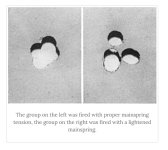Hello experts! I have a question for y'all.
I picked up a NIB 627 PC with the 2.6 inch barrel this week (I'm a big snubbie fan). It's literally a blast to shoot with full-house loads.
I've purchased 11 NIB Smiths since the beginning of 2023 and am very familiar with the current state of QC and the return process.
When I shoot .38 HBWC benched at 20 yards, the pistol hits dead-centered when the rear sight is centered. But, when I shoot Magtech 158s that are marked around 1400 fps on the box, the pistol shoots 5-inches left at 20 yards and 5-inches right with another brand of "full-house" 158s. I've never seen this happen before. Most of my experience is with J frames though. On those J frames, only elevation changes when switching between specials and mags. Sure, the mags might go an inch left or right with different loads....but not 5 inches.
My questions are these: Is the above behavior typical for a short-barreled .357 mag? Would you guys think that maybe something is off with the forcing cone or crown? To me, it looks like the barrel isn't crowned at all. It's sharp and I can see the ends of the lands/grooves cuts.
Anyway, I'd love to hear some opinions from those are familiar with hot loads in a short barrel. It's a fun pistol and pre-purchase inspection looked good (though I missed the crown).
Thanks!
I picked up a NIB 627 PC with the 2.6 inch barrel this week (I'm a big snubbie fan). It's literally a blast to shoot with full-house loads.
I've purchased 11 NIB Smiths since the beginning of 2023 and am very familiar with the current state of QC and the return process.
When I shoot .38 HBWC benched at 20 yards, the pistol hits dead-centered when the rear sight is centered. But, when I shoot Magtech 158s that are marked around 1400 fps on the box, the pistol shoots 5-inches left at 20 yards and 5-inches right with another brand of "full-house" 158s. I've never seen this happen before. Most of my experience is with J frames though. On those J frames, only elevation changes when switching between specials and mags. Sure, the mags might go an inch left or right with different loads....but not 5 inches.
My questions are these: Is the above behavior typical for a short-barreled .357 mag? Would you guys think that maybe something is off with the forcing cone or crown? To me, it looks like the barrel isn't crowned at all. It's sharp and I can see the ends of the lands/grooves cuts.
Anyway, I'd love to hear some opinions from those are familiar with hot loads in a short barrel. It's a fun pistol and pre-purchase inspection looked good (though I missed the crown).
Thanks!









